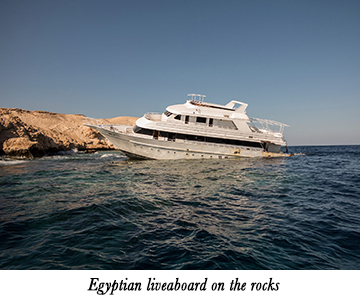Are You Safe on a Liveaboard?Contents of this Issue: Go West Diving, All West Apartments, Curaçao The Curaçao Aquarium - Not for Animal Lovers Stony Coral Disease Closes Bonaire Dive Sites Cage Diving with Great White Sharks Coming to Nova Scotia? Maybe Too Many Divers and Snorkelers Reduce Molokini Fish Populations Will Insurance Issues put Caribbean Dive Operators Out of Business? Two Liveaboards Capsize and Sink in April A New Dive Site? It's Garbage! A Unique and Serious Injury at Ramon's in Belize How Special is a PADI 5-Star Designation? Full-face Snorkeling Mask Implicated Again We Can Only Dream About Petit Mustique Editorial Office: Ben Davison Publisher and Editor Undercurrent 3020 Bridgeway, Suite 102 Sausalito, CA 94965 Not all liveaboards show adequate concern for your safety. from the May, 2023 issue of Undercurrent
Subscriber Content Preview The British idiom "Worse things happen at sea" means if things are bad ashore, they could be much worse at sea. It's a sentiment worth bearing in mind before your liveaboard leaves the dock. What may be a simple problem at home that you know to handle has a new meaning when you're on a 90-foot vessel hours from land.
In the last few years, a surprising number of liveaboards have caught fire or sunk for a variety of reasons. The tragic Conception, where there was only one viable exit, no fire alarm sounded, and no one was on watch, alerted the liveaboard world to its safety needs. We recently asked our readers for comments about the briefings and safety of liveaboards they've been aboard, and most said that they were given a full safety briefing and felt the crew would be doing their jobs. While there are problematic vessels, some are exemplary. Mike Ball's Spoilsport is one of those. Terry Cummins, aboard the Spoilsport in January, says they provided a thorough briefing before they left port (it's required by the local dive regulations and the Australian Marine Safety Authority), which outlined all fire procedures and plenty of other items like "man overboard procedures." He was shown the escape paths, which were also displayed on a poster in his cabin. They tested his cabin fire alarm during the safety briefing and gave thorough instructions about what to do in an emergency. He was shown the lifejackets in his cabin and those on the upper deck/muster stations, where the life rafts displayed their last inspection date. If he were to charge batteries in his cabin, he had to remain there. The crew and CCTV monitored battery charging stations on the open deck and lounge area. And a crew member stood watch throughout the night.... Subscribers: Read the full article here ; |

I want to get all the stories! Tell me how I can become an Undercurrent Online Member and get online access to all the articles of Undercurrent as well as thousands of first hand reports on dive operations world-wide
| Home | Online Members Area | My Account |
Login
|
Join
|
| Travel Index |
Dive Resort & Liveaboard Reviews
|
Featured Reports
|
Recent
Issues
|
Back Issues
|
|
Dive Gear
Index
|
Health/Safety Index
|
Environment & Misc.
Index
|
Seasonal Planner
|
Blogs
|
Free Articles
|
Book Picks
|
News
|
|
Special Offers
|
RSS
|
FAQ
|
About Us
|
Contact Us
|
Links
|
3020 Bridgeway, Ste 102, Sausalito, Ca 94965
All rights reserved.

 If you're on a liveaboard and a crisis arises, you can only hope that the craft was constructed with safety in mind. But, if you're properly briefed - or do your homework - you'll know whether it has been outfitted properly, whether the crew will attend to business in an emergency, and what you need to do, from finding your life jacket to knowing where to muster.
If you're on a liveaboard and a crisis arises, you can only hope that the craft was constructed with safety in mind. But, if you're properly briefed - or do your homework - you'll know whether it has been outfitted properly, whether the crew will attend to business in an emergency, and what you need to do, from finding your life jacket to knowing where to muster.